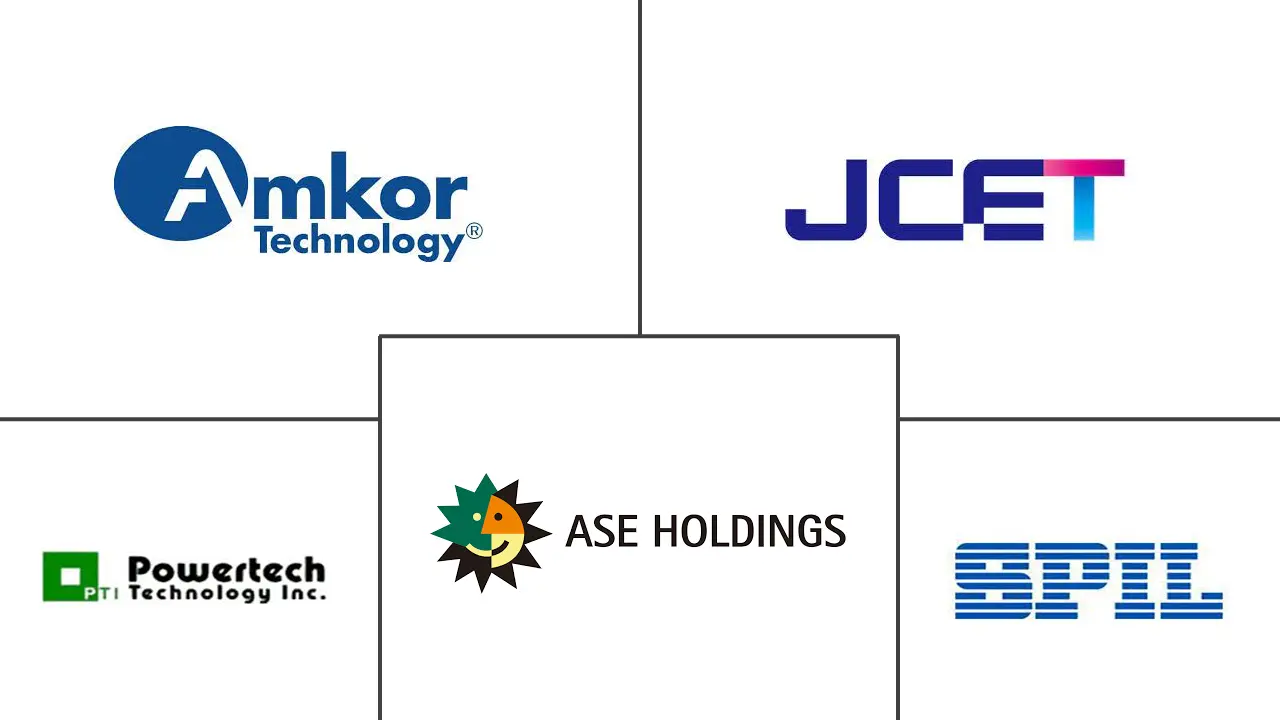Semiconductor Packaging Market Size and Share
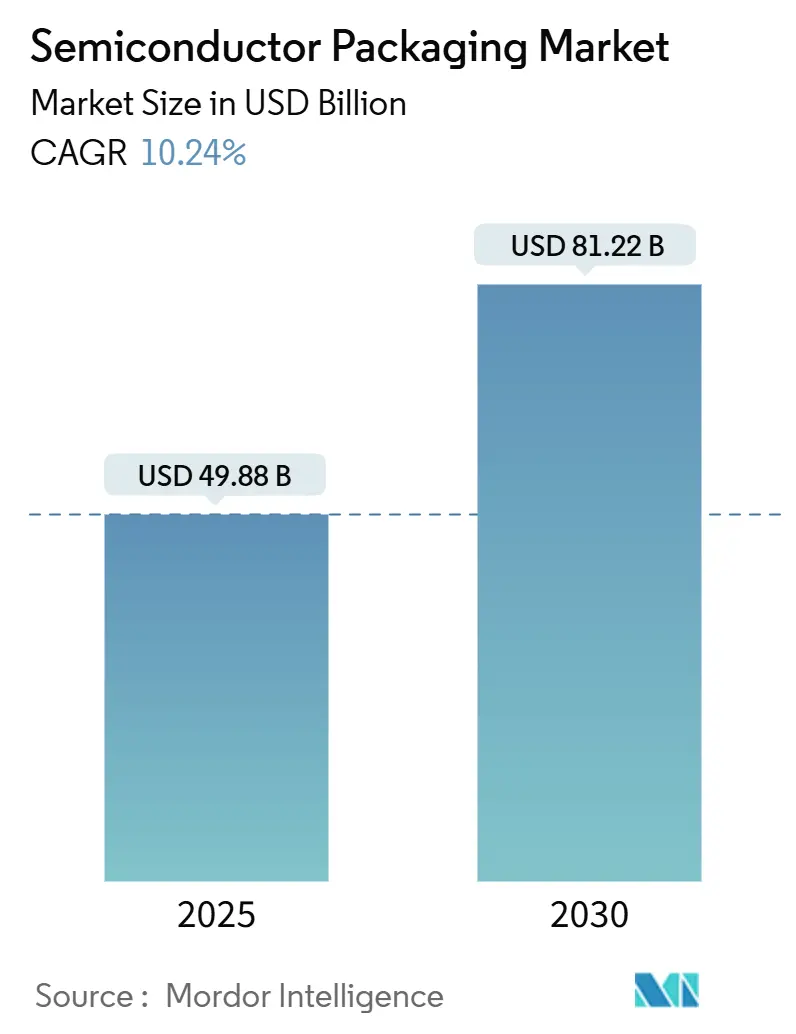
Semiconductor Packaging Market Analysis by Mordor Intelligence
The semiconductor packaging market size stood at USD 49.88 billion in 2025 and is projected to reach USD 81.22 billion by 2030, advancing at a 10.24% CAGR over 2025-2030. [1]Cheng Ting-Fang, “TSMC moves closer to next-gen packaging for Nvidia, Google AI chips,” Nikkei Asia, asia.nikkei.comA shift from cost-driven assembly toward performance-critical integration underpins this growth. Demand for 2.5D and 3D architectures has risen sharply as AI workloads call for high-bandwidth memory and superior thermal paths. Volume remains anchored in traditional wire-bond and lead-frame formats, yet value creation is migrating to fan-out wafer-level packaging (WLP) and chiplet-enabled interposers. Automotive electrification supports double-digit expansion in power-dense modules, while smartphone and PC refresh cycles sustain baseline volumes in the consumer segment. Regionally, Asia commands more than half of global output, but North America registers the highest CAGR thanks to CHIPS Act incentives that fund new back-end fabs.[2]U.S. Department of Commerce, “CHIPS for America Announces up to $300 million in Funding to Boost U.S. Semiconductor Packaging,” commerce.gov Supply bottlenecks in ABF substrates and export restrictions on advanced tools are catalyzing geographic diversification and material innovation.
Key Report Takeaways
- By packaging platform, traditional formats held 52.5% of semiconductor packaging market share in 2024, whereas fan-out WLP is forecast to expand at 12.3% CAGR to 2030.
- By end-user industry, consumer electronics led with 43.8% revenue share of the semiconductor packaging market size in 2024; automotive is pacing the fastest growth at 10.3% CAGR through 2030.
- By Wafer Size: 300 mm drives efficiency, captured 74.0% of the semiconductor packaging market share in 2024, while panel format emerges and Panel-level processing on substrates of 450 mm or more represents the fastest-growing segment at a 12.5% CAGR through 2030
- By business model, the OSAT segment controlled 62.0% of global semiconductor packaging market share in 2024 while foundry back-end services are rising at 10.9% CAGR.
- By Packaging Material, Organic ABF substrates carried 41.5% revenue in 2024, underpinning the mainstream flip-chip ecosystem
- By geography, Asia held 53.0% of the semiconductor packaging market in 2024; North America is poised for an 11.1% CAGR to 2030.
- ASE, Amkor and JCET jointly accounted for more than 30% share of advanced-technology revenue in 2024, reflecting scale advantages in hybrid bonding and SiP production
Global Semiconductor Packaging Market Trends and Insights
Drivers Impact Analysis
| Driver | (~) % Impact on CAGR Forecast | Geographic Relevance | Impact Timeline |
|---|---|---|---|
| AI accelerator boom driving 2.5D/3D interposers | +2.8% | Global (Taiwan, US, China) | Medium term (2-4 years) |
| Electrified-vehicle power packages | +1.9% | North America & APAC | Long term (≥4 years) |
| US-EU CHIPS incentives creating local back-end fabs | +1.4% | North America & EU | Long term (≥4 years) |
| 5G RF-SiP demand in China & Korea | +1.2% | APAC core | Short term (≤2 years) |
| Panel-level packaging for low-cost IoT | +0.9% | Global (APAC hubs) | Medium term (2-4 years) |
| Chiplet architectures powering high-density interposers | +1.6% | Global (US design, Taiwan mfg.) | Medium term (2-4 years) |
| Source: Mordor Intelligence | |||
AI accelerator boom driving 2.5D/3D interposers
TSMC’s CoWoS capacity is doubling from 120,000 to 240,000 units between 2023 and 2024, yet it still cannot fully meet hyperscaler demand. The capacity gap is stimulating alternative panel-level flows and 3.5D stacking trials that aggregate more than 6,000 mm² of silicon per package. [3]James Morra, “Broadcom Bets on 3.5D Packaging Technology to Build Bigger AI Chips,” Electronic Design, electronicdesign.com Advanced packaging has therefore moved from a cost center to a strategic lever for AI system performance
Electrified-vehicle power packages in United States & Asia
onsemi’s EliteSiC platform awarded by Volkswagen exemplifies the migration toward integrated power modules with superior heat dissipation. ROHM’s 6-in-1 molded SiC modules deliver triple the power density of prior. These innovations concentrate in US and Asian supply chains that can meet stringent automotive qualification.
US-EU CHIPS incentives creating local back-end fabs
The CHIPS Act earmarks USD 300 million exclusively for advanced packaging R&D, subsidizing test lines in Georgia, California and Arizona. Intel’s USD 3.5 billion Foveros site in New Mexico anchors domestic 3D integration capacity. Comparable funds in the EU aim to de-risk automotive and defense electronics from Asian supply disruptions.
5G RF-SiP demand in China & Korea
JCET's heterogeneous RF-SiP for power amplifiers increases integration density by 1.5x compared with prior nodes. While premium handsets sustain innovation, mass-tier Android demand softness has tempered unit growth, pressing suppliers to optimize cost structures
Restraints Impact Analysis
| Restraint | (~) % Impact on CAGR Forecast | Geographic Relevance | Impact Timeline |
|---|---|---|---|
| ABF substrate supply crunch | -1.8% | Global (APAC acute) | Short term (≤2 years) |
| Yield challenges in 3D TSV/hybrid bonding | -1.3% | Global (Taiwan, Korea, US) | Medium term (2-4 years) |
| Export controls on advanced packaging tools to China | -0.9% | China primary | Long term (≥4 years) |
| Thermal dissipation limits in fan-out WLP @ <5 nm | -0.7% | Global advanced nodes | Medium term (2-4 years) |
| Source: Mordor Intelligence | |||
ABF substrate supply crunch
Nittobo’s 20% price hike in August 2025 exposes systemic material tightness that particularly affects flip-chip BGA lines. Limited qualified capacity in Taiwan and Japan prolongs lead times and pushes OEMs to explore glass-core or silicon-core alternatives.
Yield challenges in 3D TSV/hybrid bonding
Copper-to-copper hybrid bonding tolerances under 0.5 nm and TSV aspect ratios beyond 10:1 multiply defect risks across stacked. NVIDIA’s Blackwell program reportedly hit yield escapes tied to CoWoS-L thermomechanical stress.
Segment Analysis
By Packaging Platform: Advanced technologies drive value migration
Traditional wire-bond and lead-frame offerings still dominated shipments with 52.5% semiconductor packaging market share in 2024, ensuring that consumer electronics and industrial devices retain affordable bill-of-materials costs. However, Fan-out WLP outpaces every other format at a 12.3% CAGR, signaling the semiconductor packaging market’s move toward substrate-free redistribution layers that shrink z-height and boost I/O density. Flip-chip bridges the gap by pairing fine-pitch bumps with moderate cost, while SiP and PoP architectures enable vertical stacking for space-constrained handsets.
On the advanced front, 2.5D interposers position high-bandwidth memory adjacent to AI logic, and 3D stacks unlock latency gains. Embedded-die and panel-level flows attract new entrants focused on IoT price points, demonstrating that the semiconductor packaging market is splitting into premium performance nodes and ultra-low-cost volume plays. In contrast, panel-level lines deliver sub-USD 0.10 per pin, a ratio that underscores divergent cost structures. As a result, equipment makers have segmented their portfolios: high-accuracy bonder clusters for 3 µm alignment coexist with large-panel MOLD lines aimed at IoT tags. Such bifurcation redefines supplier positioning inside the semiconductor packaging market.
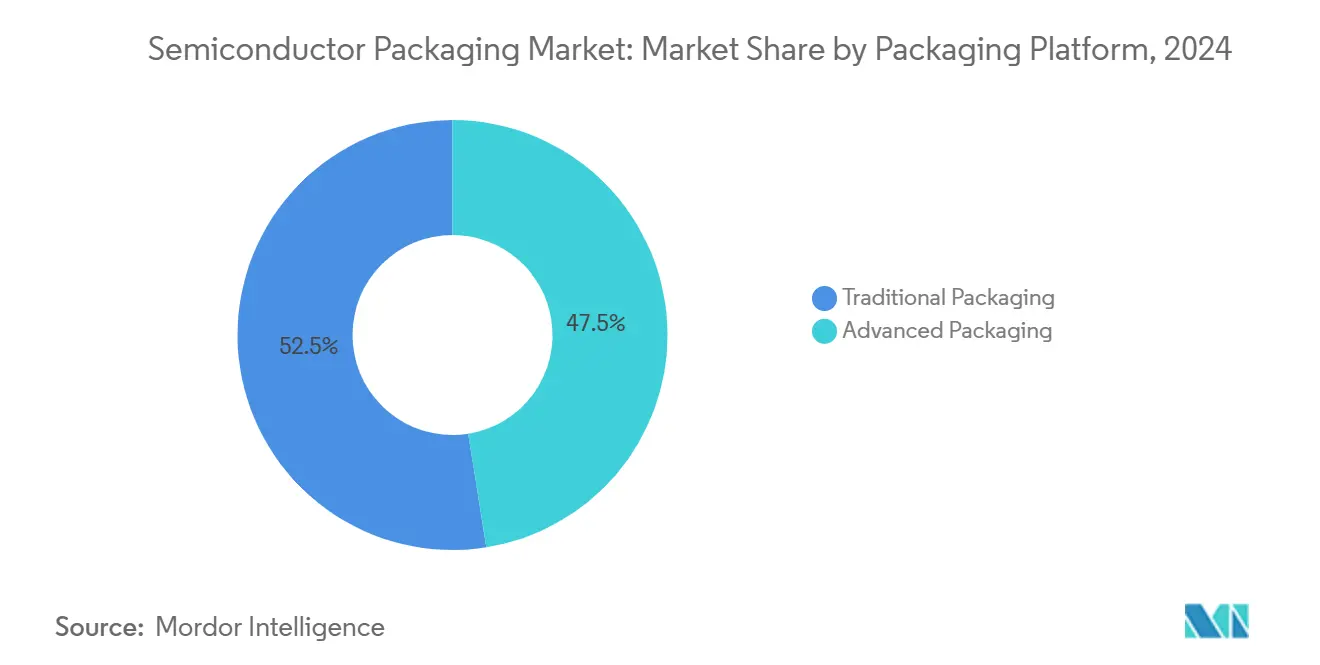
Note: Segment shares of all individual segments available upon report purchase
By Packaging Material: Organic substrates dominate amid innovation pressure
Organic ABF substrates carried 41.5% revenue in 2024, underpinning the mainstream flip-chip ecosystem. Yet semiconductor packaging market size for bonding wires is set to grow 11.4% annually as automotive and industrial sectors extend the life of proven aluminum and gold wire packages. Leadframes persist in power applications that value copper heat-spreader performance. Encapsulation resins have progressed to high-thermal-conductivity grades, supporting next-generation SiC and GaN modules.
Glass substrates could displace organic builds after 2027. Intel and Samsung prototypes show 40% via pitch reduction and near-zero CTE mismatch, lowering warpage in 3D stacks. Thermal interface materials now integrate nano-diamond fillers, cutting junction-to-case resistance by 30% in 1,200 V traction inverters. Gold price spikes compressed margins for display driver IC packaging in 2025, motivating migration to copper column bumps
By Wafer Size: 300 mm drives efficiency while panel format emerges
The 300 mm wafer format captured 74.0% of the semiconductor packaging market share in 2024, confirming its status as the preferred choice for advanced back-end flows that balance processing efficiency with front-end tool compatibility. Smaller wafers of 200 mm or less remain viable for legacy analog, sensor, and power lines where conversion costs outweigh productivity gains. Larger formats enable economies of scale that are increasingly critical as device counts climb in smartphones, PCs, and industrial IoT nodes.
Panel-level processing on substrates of 450 mm or more represents the fastest-growing segment at a 12.5% CAGR through 2030 and is poised to increase the semiconductor packaging market size by lowering per-unit material consumption and cycle times. Warpage control, inline yield metrology and equipment standardization remain the chief hurdles, requiring joint development efforts between tool makers and high-volume packaging houses.
By Business Model: OSAT leadership faces foundry challenge
OSATs retained 62.0% of semiconductor packaging market share in 2024 owing to broad customer rosters and global footprints. Yet foundry back-end expansion at 10.9% CAGR signals vertical integration. TSMC's Wafer Manufacturing 2.0 integrates lithography, test, and CoWoS into a unified service, blurring OSAT boundaries.
In response, ASE targets USD 1.6 billion in advanced-packaging revenue in 2025 through strategic capex and co-design with system OEMs. Start-ups such as Chipletz target specific market segments where custom interposer design aligns with AI inference cards, reflecting a niche penetration strategy.
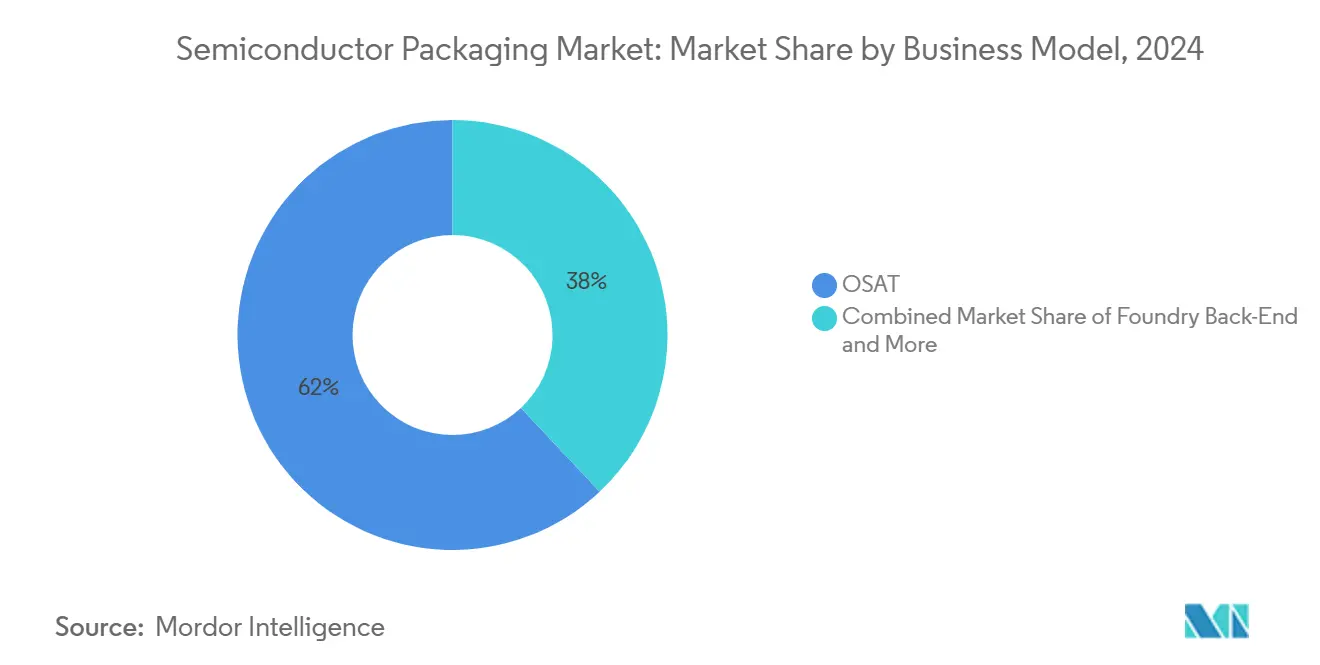
Note: Segment shares of all individual segments available upon report purchase
By End-User Industry: Consumer electronics leads while automotive accelerates
Smartphones, tablets and PCs ensured a 43.8% share of the semiconductor packaging market in 2024 as OEMs refreshed form factors and introduced generative-AI on-device capabilities. Nevertheless, the automotive vertical posts the highest CAGR at 10.3% on the back of EV inverter and ADAS domain-controller content growth.
Automotive-grade power modules command ASPs five times higher than mobile SoCs, expanding semiconductor packaging market size disproportionately versus unit volumes. Communications infrastructure contributes RF-SiP demand, while data-center HPC steers the most advanced architectures, closing the loop between AI algorithm roadmaps and physical integration choices.
Geography Analysis
Asia captured 53.0% of the semiconductor packaging market in 2024, cemented by Taiwan’s CoWoS monopoly and China’s scale in wire-bond assembly. JCET’s RMB 4.4 billion automotive plant in Jiangsu advances local competency in SiC power packages. South Korea benefits from memory-centric SiP, whereas Japan controls pivotal substrate chemistries, reinforcing a tightly knit regional cluster.
North America’s semiconductor packaging market is projected to post an 11.1% CAGR through 2030. CHIPS Act incentives amass USD 300 million for R&D lines, spawning hubs in Arizona, New Mexico and California. Partnerships such as TSMC-Amkor in Arizona build complete back-end ecosystems proximate to leading-edge wafer fabs. Canada cultivates photonics packaging, and Mexico offers low-cost final test for consumer ASICs.
Europe positions around automotive and industrial strength. German Tier-1s co-develop double-sided cooled SiC modules targeting 9 kW/L inverter density, catalyzing niche OSAT investment. The Netherlands pushes high-frequency optical transceiver packaging that aligns with vertical-cavity surface-emitting laser (VCSEL) adoption. Middle East and Africa remain emerging, primarily outsourcing assembly to Asian hubs yet planning domestic lines for secure IoT and defense electronics under sovereign mandates.
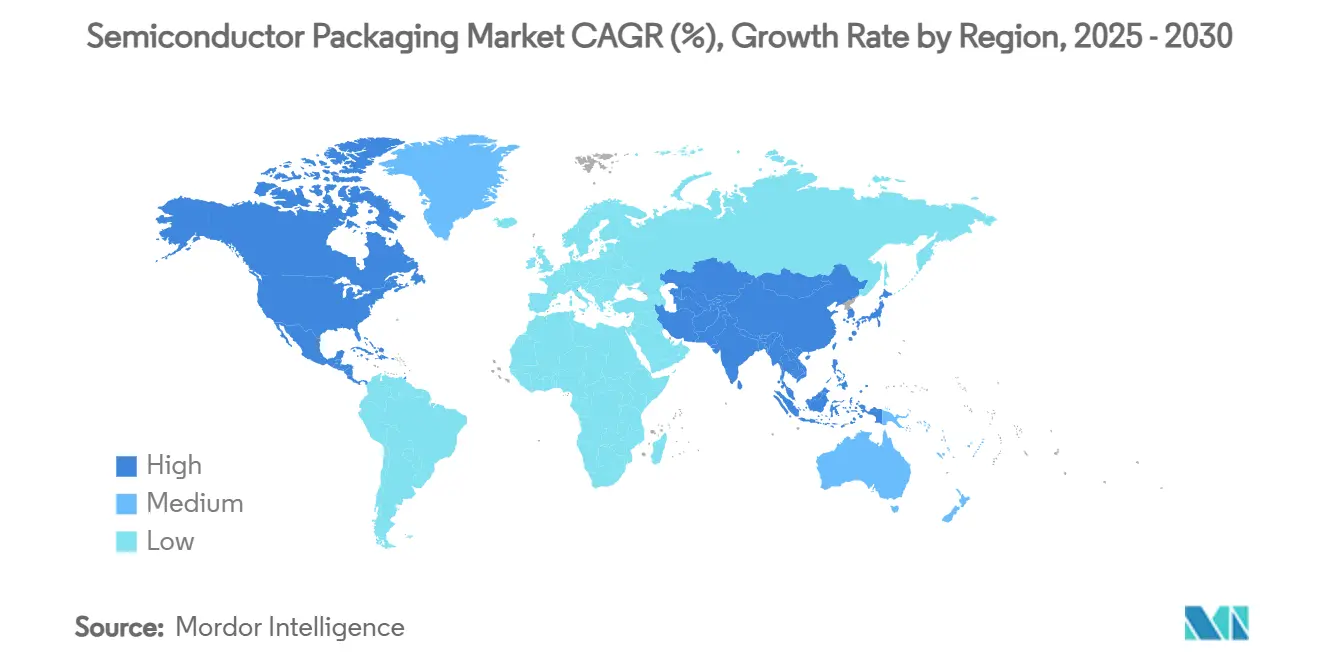
Competitive Landscape
Competitive intensity pivots from price to technology. TSMC leverages foundry know-how to dominate 2.5D interposers while Samsung employs H-cube to blend memory and logic for mobile AI. ASE and Amkor spread risk across 40+ facilities, focusing on yield learning and design-for-manufacturability services. JCET scales SiP lines running automotive AEC-Q100 flows. Intel’s Foveros plant embodies a strategic leap to regain packaging leadership, offering 50 µm die-to-die pitch for client and data-center platforms.
Barriers to entry include capex intensity, substrate supply security, and customer co-development lock-ins. Consequently, consolidation through M&A—e.g., Empyrean’s purchase of Xpeedic—reflects a bid to aggregate EDA and packaging IP under one roof
Semiconductor Packaging Industry Leaders
-
ASE Technology Holding Co., Ltd.
-
Amkor Technology, Inc.
-
JCET Group Co., Ltd.
-
Siliconware Precision Industries Co., Ltd.
-
Powertech Technology Inc.
- *Disclaimer: Major Players sorted in no particular order
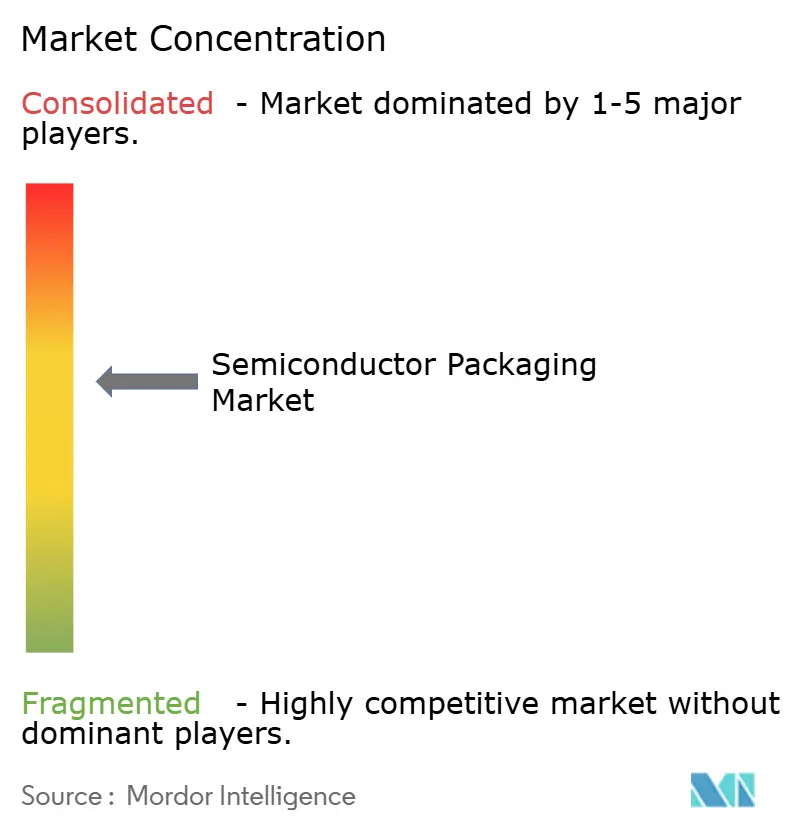
Recent Industry Developments
- June 2025: ASE and AMD partner to raise data-center efficiency by 50% while trimming power 6.5%, evaluating Instinct MI300 GPUs for AI workloads
- June 2025: Infineon unveils trench-based SiC super-junction MOSFETs, targeting traction inverters with first 1,200 V devices in ID-PAK packages
- May 2025: ROHM releases 4-in-1 and 6-in-1 SiC molded modules that triple power density and shrink board area 52%
- April 2025: ASE demonstrates co-packaged optics cutting link energy to <5 pJ/bit amid 24.9% data-center bandwidth CAGR forecast
Research Methodology Framework and Report Scope
Market Definitions and Key Coverage
Our study treats the semiconductor packaging market as all revenue earned from the sale of finished device packages, traditional lead-frame formats as well as advanced solutions such as fan-out wafer-level, flip-chip, 2.5D, and 3D stacked structures that protect, interconnect, and thermally manage integrated circuits.
Sales of ancillary equipment, raw materials, and front-end foundry services sit outside this boundary. Scope Exclusion: Packaging equipment, packaging materials, and outsourced test services remain out of scope unless they directly form part of the package value.
Segmentation Overview
- By Packaging Platform
- Advanced Packaging
- Flip-Chip
- Fan-Out WLP
- Fan-In WLP
- 2.5D / 3D IC
- Embedded-Die
- SiP / PoP
- Panel-Level Packaging
- Traditional Packaging
- Wire-Bond
- Leadframe
- QFN / QFP / SOP
- Advanced Packaging
- By Packaging Material
- Organic Substrates
- Leadframes
- Bonding Wires
- Encapsulation Resins
- Ceramic Packages
- Solder Balls and Bumps
- Die-Attach and TIMs
- By Wafer Size
- ≤ 200 mm
- 300 mm
- ≥ 450 mm / Panel
- By Business Model
- OSAT
- Foundry Back-End
- IDM In-house
- By End-user Industry
- Consumer Electronics
- Smartphones and Wearables
- Computing / Data-Center
- Automotive and Mobility
- ADAS / EV Power
- Communications and Telecom
- 5G Infrastructure
- Aerospace and Defense
- Medical and Healthcare Devices
- Industrial and Energy (LED / Power)
- Consumer Electronics
- By Geography
- North America
- United States
- Canada
- Mexico
- South America
- Brazil
- Rest of South America
- Europe
- Germany
- France
- United Kingdom
- Italy
- Netherlands
- Nordics
- Rest of Europe
- Middle East and Africa
- Israel
- Turkey
- GCC
- South Africa
- Rest of Middle East and Africa
- APAC
- China
- Taiwan
- South Korea
- Japan
- India
- Singapore
- Australia
- New Zealand
- Rest of APAC
- North America
Detailed Research Methodology and Data Validation
Primary Research
Mordor analysts interview OSAT executives, foundry back-end managers, substrate suppliers, and purchasing leads across Asia, North America, and Europe. Conversations validate average selling prices, yield drifts, and the pace at which automotive accounts convert from wire-bond to flip-chip. Follow-up surveys with packaging design engineers clarify the expected share of 2.5D/3D architectures in AI accelerators during the forecast window.
Desk Research
Publicly available tier-one sources form our starting grid. Data from organizations such as SEMI, WSTS, and national customs portals outline production, trade, and capital-spending flows, while JEITA and SIA bulletins reveal demand signals in downstream electronics. Company 10-Ks, investor decks, and patent registries add contextual color on technology migration toward chiplets and hybrid bonding. To fill regional gaps, we access paid repositories (D&B Hoovers for corporate revenue splits and Dow Jones Factiva for deal news). The list above is illustrative, and many additional sources guide the desk phase.
Government incentives, for example, the U.S. CHIPS Act award list, and trade association shipment tallies help us capture fingerprints such as ABF substrate price spikes, fan-out line utilization, and panel-level pilot volumes, providing real-time anchors for the model.
Market-Sizing & Forecasting
A top-down reconstruction starts with global semiconductor sales, filters through packageable die share, and applies penetration factors for each packaging platform; selective bottom-up checks, sampled OSAT revenue roll-ups and ASP × volume calculations, tune the totals. Key variables include advanced-node wafer starts, substrate capacity additions, fan-out panel shipments, average layer count in HBM stacks, automotive semiconductor content per vehicle, and prevailing ASP deltas between traditional and advanced formats. Multivariate regression projecting these drivers underpins the 2025-2030 outlook. Gap areas, such as captive in-house packaging at IDMs, are bridged with calibrated ratios from expert interviews before final reconciliation.
Data Validation & Update Cycle
Draft numbers pass variance screens against trade, pricing, and company guidance benchmarks, then move to a two-level analyst review. Our models refresh every twelve months, with interim revisits if material events, like a substrate fab fire or a sudden export control, shift baseline assumptions.
Why Mordor's Semiconductor Packaging Baseline Proves Dependable
Published estimates often diverge because firms pick different coverage slices, currency bases, or refresh cadences. Users want clarity on why totals vary and which figure deserves confidence.
Key gap drivers arise when others bundle packaging materials, exclude advanced fan-out lines, or convert currencies at spot rather than full-year averages, thereby understating 2025 inflammation effects. Some providers freeze scenarios for three-plus years, while Mordor's annual refresh captures new CHIPS-funded capacity and the 19% surge in AI-driven 2.5D demand.
Benchmark comparison
| Market Size | Anonymized source | Primary gap driver |
|---|---|---|
| USD 49.88 B (2025) | Mordor Intelligence | |
| USD 43.95 B (2024) | Global Consultancy A | Excludes advanced fan-out and 2.5D volumes; uses spot FX |
| USD 55.02 B (2025) | Regional Consultancy B | Bundles packaging materials and test services; limited primary validation |
In sum, Mordor Intelligence delivers a balanced, transparent baseline rooted in clearly defined scope, annually refreshed variables, and dual validation steps, giving decision-makers a figure they can trace and replicate with confidence.
Key Questions Answered in the Report
What is the current value of the semiconductor packaging market?
The semiconductor packaging market is valued at USD 49.88 billion in 2025 and is projected to reach USD 81.22 billion by 2030.
Which packaging technology is growing the fastest?
Fan-out wafer-level packaging is the fastest-growing platform, advancing at a 12.3% CAGR through 2030.
Why are ABF substrates a bottleneck?
ABF substrates are produced mainly in Taiwan and Japan, and supply shortages have driven price increases of 20%, limiting flip-chip capacity expansion.
How does the CHIPS Act affect packaging?
The CHIPS Act allocates USD 300 million for domestic advanced-packaging R&D, fostering new fabs in Arizona, California and New Mexico and raising North America’s CAGR to 11.1%.
Which end-use sector will see the highest growth?
Automotive applications will post the highest growth at a 10.3% CAGR, driven by electric-vehicle power electronics and ADAS demand.
How are chiplet architectures influencing packaging design?
Open standards like UCIe 2.0 enable heterogeneous chiplets, pushing packaging toward high-density interposers and hybrid bonding for higher bandwidth and lower latency.
Page last updated on:
